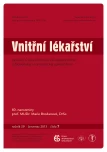-
Medical journals
- Career
Effect of liver cirrhosis on pharmacokinetics and pharmacodynamics of drugs
Authors: F. Perlík
Authors‘ workplace: Farmakologický ústav 1. lékařské fakulty UK a VFN Praha, přednosta doc. MU Dr. Ondřej Slanař, Ph. D.
Published in: Vnitř Lék 2013; 59(7): 584-586
Category:
Overview
Metabolic liver functions are significantly involved in the total clearance of a number of drugs. In liver cirrhosis the reduced drug elimination is a result of the blood flow through the liver, hepatocytes function and volume of hepatic tissue. Pharmacokinetic and pharmacodynamic changes depend on the nature and degree of hepatic impairment and on the characteristics of the dosed drug. Hepatocytes have a different extraction ability with respect to the individual drugs. The following are examples of drugs with high hepatic extraction: anodyne, propranolol, metoprolol, verapamil and lidocaine. These drugs are significantly dependent on the first passage through the liver. Intrahepatic and extrahepatic collateral blood flows significantly increase their biological availability and reduce the clearance. The reduction in hepatic clearance of drugs with low extraction coefficient, such as chlordiazepoxide, diazepam or furosemide, is a result of its own limited functional capacity to eliminate the drug. Predicting a hepatic metabolic disorder based on a common biochemical assessment of enzyme activities is not sufficient. In advanced liver cirrhosis a higher risk is demonstrated for drugs with a narrow therapeutic width. It is always necessary to take into account whether the pharmacotherapy is necessary, use small doses and cautiously monitor the patient.
Key words:
drug clearance – pharmacodynamics – pharmacokinetics – liver cirrhosis – dose adjustment
Sources
1. Perlík F, Haller A, Brodanová M et al. Změny farmakokinetiky trimekainu u nemocných s jaterní cirhózou. Sb Lék 1991; 93 : 287 – 292.
2. Verbeeck RK. Pharmacokinetics and dosage adjustment in patients with hepatic dysfunction. Eur J Clin Pharmacol 2008; 64 : 1147 – 1161.
3. Doligalski CT, Tong Logan A, Silverman A. Drug interactions: a primer for the gastroenterologist. Gastroenterol Hepatol (NY) 2012; 8 : 376 – 383.
4. Slanař O, Perlík F. Izoenzym cytochromu P450 – 1A2 a jeho fenotypizace. Klin Farmakol Farmac 2002; 16 : 19 – 22.
5. Ramond MJ, Comoy E, Lebrec D. Alterations in isoprenaline sensitivity in patients with cirrhosis: evidence of abnormality of the sympathetic nervous activity. Br J Clin Pharmacol 1986; 21 : 191 – 196.
6. Janku I, Perlik F, Tkaczykova H et al. Disposition kinetics and concentration-effect relationship of metipranolol in patients with cirrhosis and healthy subjects. Eur J Clin Pharmacol 1992; 42 : 337 – 340.
7. Dao MT, Villeneuve JP. Kinetics and dynamics of triamterene at steady ‑ state in patients with cirrhosis. Clin Invest Med 1988; 11 : 6 – 9.
8. Slanar O, Aubrecht J, Perlík F. Noninvasive evaluation of portal ‑ systemic shunting by glyceryl ‑ trinitrate. Physiol Res 2002; 51 : 413 – 416.
9. Sokol SI, Cheng A, Frishman WH et al. Cardiovascular drug therapy in patients with hepatic diseases and patients with congestive heart failure. J Clin Pharmacol 2000; 40 : 11 – 30.
10. McCabe SM, Ma Q, Slish JC et al. Antiretroviral therapy: pharmacokinetic considerations in patients with renal or hepatic impairment. Clin Pharmacokinet 2008; 47 : 153 – 172.
11. Klotz U. Antiarrhythmics: elimination and dosage considerations in hepatic impairment. Clin Pharmacokinet 2007; 46 : 985 – 996.
Labels
Diabetology Endocrinology Internal medicine
Article was published inInternal Medicine

2013 Issue 7-
All articles in this issue
- Liver disorders in diabetic patients
- Effects of GLP-1 (glucagon‑like peptide‑ 1) on liver
- Digestive tract polyposes
- Neonatal hyperbilirubinemia and molecular mechanisms of jaundice
- Cystic tumors of the pancreas – our experience with diagnostics
- Wilson’s disease
- Effect of liver cirrhosis on pharmacokinetics and pharmacodynamics of drugs
- Hepatic cein catheterisation – selected assessment aspects
- Reactivation of chronic hepatitis B
- Acute pancreatitis – new developments in treatment
- Hepatic involvement in patients with non‑Hodgkin’s lymphoma
- Treatment of chronic hepatitis C virus infection at the beginning of a new era
- Relationship of bilirubin to diseases caused by increased oxidative stress
- Tyrosine kinase inhibitors – major change in the prognosis of chronic myeloid leukaemia
- Multiple myeloma
- Advances in the treatment of chronic lymphocytic leukaemia
- Myelodysplastic syndromes – therapy progress over the last two decades
- Internal Medicine
- Journal archive
- Current issue
- Online only
- About the journal
Most read in this issue- Relationship of bilirubin to diseases caused by increased oxidative stress
- Cystic tumors of the pancreas – our experience with diagnostics
- Liver disorders in diabetic patients
- Acute pancreatitis – new developments in treatment
Login#ADS_BOTTOM_SCRIPTS#Forgotten passwordEnter the email address that you registered with. We will send you instructions on how to set a new password.
- Career

